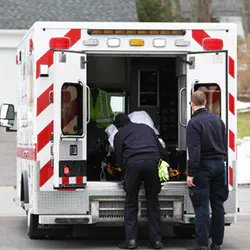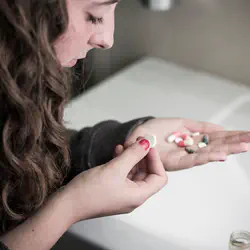DRUGS: WHAT YOU
NEED TO KNOW Booklet

Signs and Symptoms of Prescription Depressants Addiction

What are prescription depressants? These are drugs that depress the function of the central nervous system (CNS). In general, they are used to reduce anxiety or bring about sleep.
There are three different classes of depressants: barbiturates, benzodiazepines and sedative-hypnotics. Each class includes multiple medications. Each medication has a generic name for the drug being prescribed and one or more brand names. Here are the most popular drugs in each class, with the generic name listed first and a commonly recognized brand name listed after.
Barbiturates
- mephobarbital (Mebaral)
- phenobarbital (Luminal)
- pentobarbital sodium (Nembutal)
Benzodiazepines
- diazepam (Valium)
- clonazepam (Klonopin)
- alprazolam (Xanax)
- triazolam (Halcion)
- estazolam (Prosom)
Sedative-Hypnotics
- zolpidem (Ambien)
- eszopiclone (Lunesta)
- zaleplon (Sonata)
Other Depressants
Flunitrazepam (Rohypnol) is another type of benzodiazepine that some people are addicted to or misuse. It is not available by prescription in the United States which means that it is only available on the illicit market. It is readily available in Mexico and may be trafficked into the U.S. by those who wish to use the drug for the purpose of date rape because of its tendency to cause memory loss.

Other than flunitrazepam, benzodiazepines and barbiturates are generally prescribed for a person who is anxious, overwrought, or unable to sleep.1 They act by making a person relaxed and sleepy. But because they act on the CNS, too much of any of these drugs can be deadly because they can stop a person’s breathing. Sedative hypnotics are generally prescribed only for sleep problems.
Some agencies analyzing drug abuse also include these muscle relaxants along with other depressants.
- carisoprodol (Soma)
- cyclobenzaprine (Flexeril)
Muscle relaxants may be prescribed after an injury or accident that causes the muscles to tighten up or become sore. However, because they are also CNS depressants, they are equally dangerous to take in high doses or to mix with other drugs.
Misuse of CNS Depressants
CNS depressants may be misused by a person who wishes to self-prescribe for their own anxiety or for someone who wants to experience the drugs’ euphoric effects.2 When mixed with opioids such as oxycodone or hydrocodone, they make the effects of the opioid more potent, a desirable effect among some drug users. Some people seeking a heroin-type high say that mixing opioids and benzodiazepines will provide a similar kick to that of heroin.
Polydrug use that includes a CNS depressant in addition to alcohol or opioids is very common. When depressants are combined with opioids, there is a higher risk of overdose deaths. That’s because all these drugs slow down the CNS, including a person’s breathing, which can cause death when it becomes severe enough. There is also a higher risk of suicide when these drugs are mixed.3
Depressants Are Widely Abused
According to the Substance Abuse and Mental Health Services Administration, millions of people are abusing these drugs every year.4
In 2020:
- 4.8 million misused a benzodiazepine
- 6.2 million misused a tranquilizer or sedative
There could be an overlap in these numbers, meaning that some people misuse both types of drugs.

Young adults were the most common abusers of these drugs with 1.1 million misusing a benzodiazepine and 1.2 million misusing a tranquilizer or sedative.
The statistic that shows that many people do not understand the dangers of these drugs is the number of people initiating abuse of sedatives or tranquilizers. More than 343,000 people start misusing sedatives every year and nearly a million begin misusing tranquilizers.
Even high numbers of adolescents misuse these drugs, perhaps because they are readily available in their households. In 2020, 157,000 youth aged 12 to 17 misused a sedative and 226,000 youth misused a tranquilizer.
Symptoms of Depressant Misuse or Addiction
Whether a person misuses these drugs or is addicted to them, the following signs may be seen:
- slurred speech
- poor concentration
- confusion
- headache
- dizziness and light-headedness
- dry mouth
- reduced blood pressure
- slower breathing
Misuse of a prescription drug means that someone is taking a drug not prescribed for them or they are taking it in a way that is not recommended. This could mean that they are crushing a pill and snorting it, dissolving it and injecting it, taking a higher dose than prescribed or taking a recommended dosage more frequently.

Slower breathing can reduce the person’s breathing until the brain is not getting enough oxygen to sustain life. As mentioned, mixing different CNS depressants such as alcohol, opioids (painkillers, heroin), or any of these drugs can cause a person to fatally overdose.
Benzodiazepines by themselves are unlikely to cause an overdose but it is possible if enough of the drug is taken. It is this characteristic that caused benzodiazepines to overtake barbiturates as popular drugs to be prescribed for anxiety or sleeplessness. Barbiturates are much more likely to cause fatal overdoses.
Dependence and Addiction
All of these drugs can create dependence, which means that a person will go into withdrawal if they stop using the drug and that they have developed a tolerance. A person with a tolerance to a drug will need to take more of it to get the same effect that a smaller dose used to create. When a person is also psychologically dependent on the drug, in other words, they depend on this drug to get through their day and don’t feel they can do without it, they are then described as addicted.
Physical Signs of Depressant Addiction
In addition to the symptoms listed above, these signs may be seen:
- restlessness
- slowed actions
- delirium
- lack of coordination
Behavioral and Mental Signs of Depressant Use
The mental effects of depressant addiction can be profound. They may include:
- amnesia
- depression
- aggression
- hallucinations
- paranoia
The higher the dosages and more severe the addiction, the more serious the effects.
A person who is taking more depressants than prescribed may be seen asking for early refills or trying to find more than one doctor to prescribe one of these medications.
The Long-Term Damage of Depressant Addiction
When a person stays addicted to these drugs for a long duration, these problems may be added to the physical and mental signs of depressant use.
- personality change
- weakness
- lethargy
- lack of motivation
- fatigue
- disturbing dreams
Withdrawal from Depressants
Some of the symptoms of withdrawal from these drugs include the mental and emotional symptoms the person was complaining of when the drugs were first prescribed (if they ever were legitimately prescribed). The symptoms a person may experience as they withdraw from these drugs include:
- anxiety
- insomnia
- generalized unhappiness and dissatisfaction
- tremors
- irritability
- panic attacks
- difficulty in concentration
- nausea
- vomiting
- palpitations
- cravings
- muscle pain
- hallucinations
The Special Challenges of Withdrawal
With some of these drugs, withdrawal symptoms may be significantly delayed. These symptoms may not begin for seven to ten days after use of the drug has ceased. In other cases, withdrawal will start within hours.
There is a similarity between the symptoms that get doctors to start prescribing these drugs and the symptoms of withdrawal. For that reason, some people will give up trying to get sober and start using these drugs again as soon as withdrawal hits in earnest. It is vital to get sufficient support and supervision as well as medical monitoring during withdrawal to improve the chances of success.
Withdrawal from high dosages of benzodiazepines can cause seizures and psychotic episodes which must be monitored by a medical professional to prevent injury. Therefore, a person who wishes to come off these drugs should work with a qualified medical professional to either taper off these drugs gradually or receive medical support during withdrawal.
With the right support and assistance in building an independent life again, it is possible to enjoy a drug-free life after addiction to CNS depressants.
Sources:
-
NIH. “Prescription Sedative Misuse and Abuse. NIH, 2015. NIH Article ↩︎
-
CDC. “Polysubstance Use Facts.” CDC, 2022. CDC Article ↩︎
-
CMS. “Reduce Risk of Opioid Overdose Deaths by Avoiding and Reducing Co-Prescribing Benzodiazepines.” CMS, 2019. CMS Publication (PDF) ↩︎
-
SAMHSA. “Key Substance Use and Mental Health Indicators in the United States: Results from the 2020 National Survey on Drug Use and Health.” Substance Abuse and Mental Health, 2022. SAMHSA Article (PDF) ↩︎


